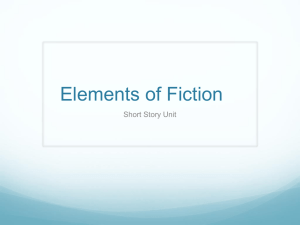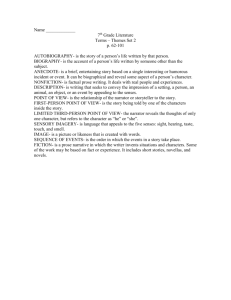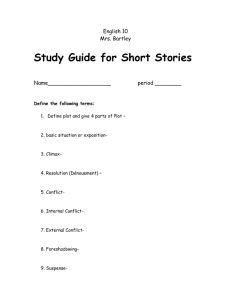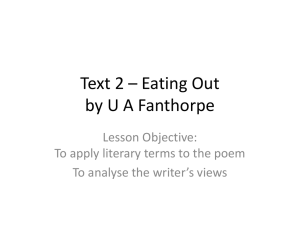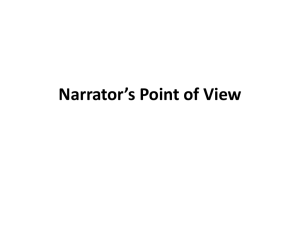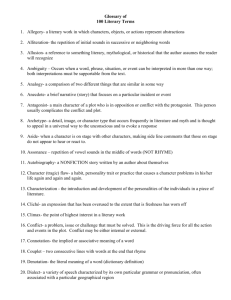Q1 Lit Terms
advertisement
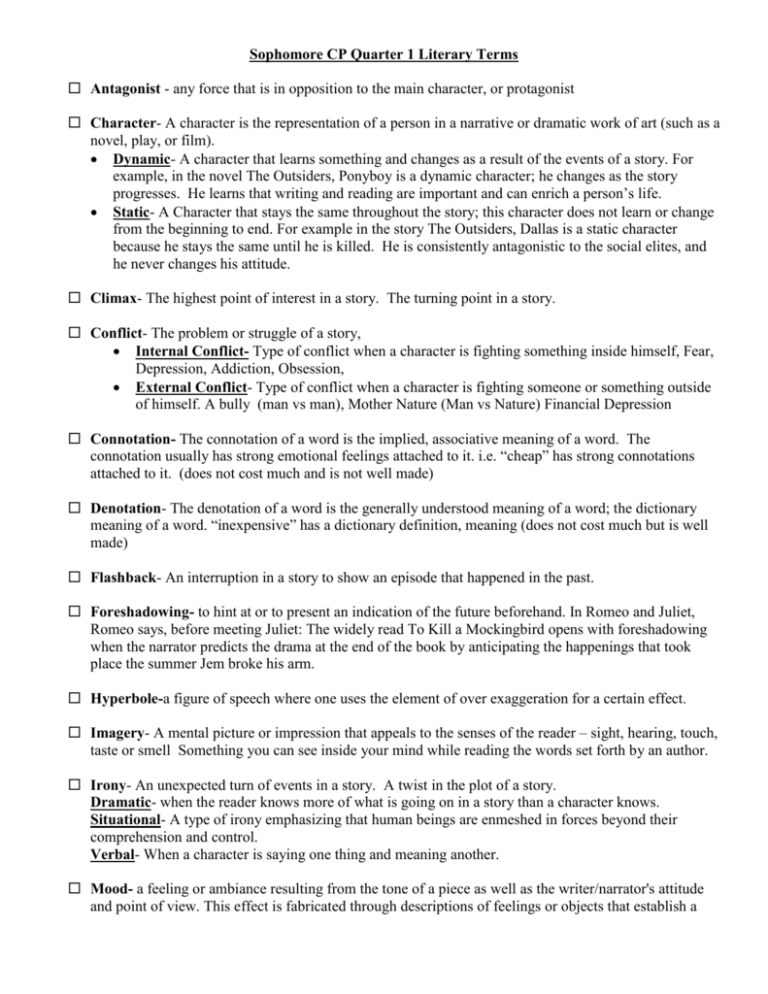
Sophomore CP Quarter 1 Literary Terms Antagonist - any force that is in opposition to the main character, or protagonist Character- A character is the representation of a person in a narrative or dramatic work of art (such as a novel, play, or film). Dynamic- A character that learns something and changes as a result of the events of a story. For example, in the novel The Outsiders, Ponyboy is a dynamic character; he changes as the story progresses. He learns that writing and reading are important and can enrich a person’s life. Static- A Character that stays the same throughout the story; this character does not learn or change from the beginning to end. For example in the story The Outsiders, Dallas is a static character because he stays the same until he is killed. He is consistently antagonistic to the social elites, and he never changes his attitude. Climax- The highest point of interest in a story. The turning point in a story. Conflict- The problem or struggle of a story, Internal Conflict- Type of conflict when a character is fighting something inside himself, Fear, Depression, Addiction, Obsession, External Conflict- Type of conflict when a character is fighting someone or something outside of himself. A bully (man vs man), Mother Nature (Man vs Nature) Financial Depression Connotation- The connotation of a word is the implied, associative meaning of a word. The connotation usually has strong emotional feelings attached to it. i.e. “cheap” has strong connotations attached to it. (does not cost much and is not well made) Denotation- The denotation of a word is the generally understood meaning of a word; the dictionary meaning of a word. “inexpensive” has a dictionary definition, meaning (does not cost much but is well made) Flashback- An interruption in a story to show an episode that happened in the past. Foreshadowing- to hint at or to present an indication of the future beforehand. In Romeo and Juliet, Romeo says, before meeting Juliet: The widely read To Kill a Mockingbird opens with foreshadowing when the narrator predicts the drama at the end of the book by anticipating the happenings that took place the summer Jem broke his arm. Hyperbole-a figure of speech where one uses the element of over exaggeration for a certain effect. Imagery- A mental picture or impression that appeals to the senses of the reader – sight, hearing, touch, taste or smell Something you can see inside your mind while reading the words set forth by an author. Irony- An unexpected turn of events in a story. A twist in the plot of a story. Dramatic- when the reader knows more of what is going on in a story than a character knows. Situational- A type of irony emphasizing that human beings are enmeshed in forces beyond their comprehension and control. Verbal- When a character is saying one thing and meaning another. Mood- a feeling or ambiance resulting from the tone of a piece as well as the writer/narrator's attitude and point of view. This effect is fabricated through descriptions of feelings or objects that establish a sense of fear, patriotism, sanctity, hope, etc. For example, many of Thomas Hardy/s novels, such as Jude the Obscure, have been accused of establishing moods of relentless gloom, depression, and despair. Narrator- the "character" who "tells" the story, or in poetry, the persona. It may be First or Third Person, limited or omniscient. Personification- treating an abstraction or nonhuman object as if it were a person by endowing it with human qualities. William Wordsworth speaks of the stars as 'Tossing their heads in sprightly dance" and Robert Browning describes "leaping waves" in his poem "Meeting at Night' In Joyce Kilmer's poem "Trees," the tree displays some very human characteristics: when an author attributes human traits to an animal or idea. The sun is smiling today. The candle winked as the wind danced. Plot- A planned sequence of events leading to the ending of a story. The plan of a story. Exposition- that part of the structure that sets the scene, introduces and identifies characters, and establishes the situation at the beginning of a story or play. Rising Action – The development of action in a work, usually at the beginning. The first part of plot structure (see falling action)., Climax- The most intense, exciting, or important point of something; a culmination or apex Falling Action- that part of plot structure in which the complications of the rising action are untangled. This is also known as the denouement. Resolution- The action of solving a problem, dispute, or contentious matter Point of View- perspective from which a story is told. Understanding the point of view used in a work is critical to understanding literature; it serves as the instrument to relay the events of a story, and in some instances the feelings and motives of the character(s). Omniscient Point of View- The narrator is god-like, telling us all the characters’ feelings and thoughts in a story. First Person Point of View- “I” is the narrator (either the author or a character) Protagonist- The main character with whom the reader identifies, who may or may not be heroic. Ponyboy is the protagonist in The Outsiders. The story centers on his thoughts and actions. We, the readers, learn about human nature and life in general through him. Setting- the time and place of the action in a story, poem, or play. George Lucas's Star Wars opens by telling us that it was "A long time ago in a galaxy far, far away:' Symbol- a person, place, thing, event, or pattern in a literary work that designates itself and at the same time figuratively represents or "stands for" something else. Often the thing or idea represented is more abstract, general, non- or super rational than the symbol, which is more concrete and particular. The poem "The Sick Rose" by William Blake, is full of symbolism: An object that represents something else in a story. For example, in the great novel Moby Dick, Captain Ahab’s ivory leg is a symbol for his insane desire to get revenge for losing his real leg to the big whale. Theme- The moral or lesson to be learned from a story about life or human nature. Typical themes include: Love, War, human relationships, coming of age, death, human emotions, etc. Tone- The implied attitude of a writer toward the subject or characters he or she is writing about. The attitude can be sympathetic, empathetic, condescending.
